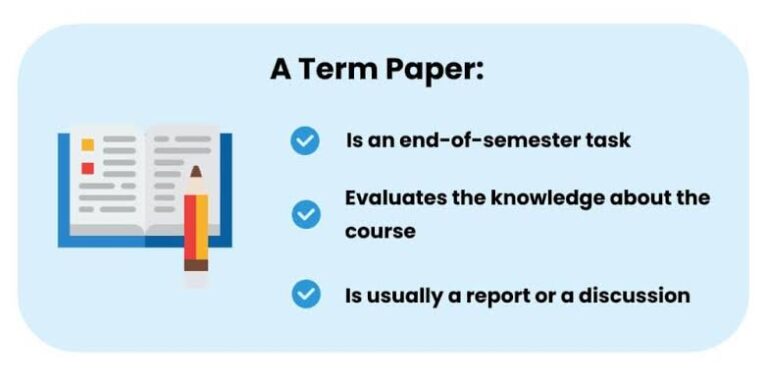The conclusion of a term paper is just as important as the introduction and body. It’s your last chance to leave a strong, positive impression on the reader. Concluding a term paper effectively involves summarizing key points, reiterating the thesis statement, and offering insightful reflections or suggestions for future research, providing closure and leaving a lasting impression on the reader with the help of Write My Paper academic service to ensure a polished and cohesive final product.
An effective conclusion should summarize key points, reinforce your thesis, and end on an impactful note. Follow these tips for writing a strong concluding section:
Summarize Key Points
Don’t simply restate your thesis word-for-word. Instead, summarize the main points and arguments made throughout the paper. This reminds the reader of the core ideas and evidence presented, acting as a wrap-up of your research.
For example: “In this paper, the key factors leading to the Civil War have been analyzed, including economic divides, states’ rights, and the issue of slavery. Evidence has been provided to support the thesis that slavery was the central cause of the conflict.”
Reinforce Thesis Statement
After summarizing, re-emphasize the main argument that has threaded throughout the paper. This drives home the point one final time.
For example: “The research and analysis provided confirms that the fundamentally opposed views on slavery between the North and South were the primary catalyst leading to the Civil War.”
End on an Impactful Note
In concluding a term paper, it’s valuable to reemphasize the significance of the research conducted, reflect on its broader implications, and encourage further exploration of the topic, thereby leaving the reader with a sense of fulfillment and curiosity, while also leveraging critical thinking writing services at https://www.linkedin.com/pulse/6-premier-critical-thinking-writing-services-2023-expert-gloria-kopp-zlofe for additional insights and guidance in crafting a compelling conclusion.
The conclusion needs a strong finish to leave a lasting impression. Consider these options:
- Propose a call to action
- Suggest further research
- Reflect on larger significance of topic
- Close with a warning, prediction, or thought-provoking question
For example: “The Civil War illustrates what can happen when a nation reaches irreconcilable differences on fundamental human rights issues. As the battle over rights continues today, our nation must find ways to engage in civil discourse rather than allow divides to intensify into violence and instability.”
Other Tips
- Keep conclusion brief – no new information should be introduced
- Reread introduction to maintain a consistent tone and style
- Avoid phrases like “in conclusion” or “in summary”
- Proofread thoroughly for errors
By restating key points, reiterating your thesis, and ending with an impactful final note, you can write an engaging conclusion that enhances your overall term paper.
Crafting An Impactful Closing Sentence
Your final sentence is what the reader will remember most. Here are some strategies for making it powerful and memorable:
- End with a warning or call to action: “If society fails to learn from past mistakes like the Civil War, we risk repeating history’s most painful chapters.”
- Loop back to introduction: “Just as sectional divides threw the nation into chaos in the 1860s, Americans must find common ground on divisive issues today.”
- Consider future implications: “Understanding the true origins and costs of the Civil War remains essential as the US continues striving towards that more perfect union envisioned by its founders.”
- Discuss unanswered questions: “More research remains needed to fully understand the complex factors that tore one nation apart into two warring sections.”
- Provide a quotation: “‘A house divided against itself cannot stand.’ Lincoln’s words remain relevant as new divisions threaten to challenge the nation’s stability.”
With creativity and focus on your audience, you can craft a final sentence to deliver maximum impact. The closing lines are what will linger after the reading is done. Make them count.
Structuring Your Conclusion
Conclusions generally follow a standard structure, though you can adjust it to fit your paper’s specific needs:
Opening Sentence
Start by signaling to the reader that this is the conclusion with a clear opening sentence. Phrases like “In conclusion” or “To summarize” work well.
“In conclusion, this paper has analyzed the primary factors that led to the outbreak of the Civil War.”
Summary of Main Points
Provide a quick recap of your main points, arguments, evidence, and findings. Don’t repeat in detail; just highlight.
“The key factors leading to the Civil War have been traced back to economic, political, and social differences between the Northern and Southern states. The divisive issue of slavery, in particular, proved insurmountable, eventually causing the Southern states to secede and the North to use force to preserve the Union.”
Thesis Restatement
Directly reiterate your thesis statement, emphasizing your central argument one last time.
“As evidenced in this paper, the fundamental dispute over slavery was the driving force behind the division of the nation and the advent of the Civil War.”
Concluding Statement
End with a final statement that gives the reader something impactful to reflect on. See tips above for strategies.
“Understanding how lack of compromise and empathy can fracture a nation remains deeply relevant to avoiding destructive divisions in our society today.”
This basic structure provides cohesion and closure, driving home your thesis and main ideas in a clear, concise way. Customize to highlight the most important elements for your unique paper.
Length and Style Considerations
When writing the conclusion, keep these guidelines on length and style in mind:
Length
- 1-2 paragraphs for a short paper (5-10 pages)
- 3-4 paragraphs for a standard paper (10-15 pages)
- 5-7 paragraphs for long papers (15-25 pages)
Don’t devote too much length to reiterating points made elsewhere. Stick to a brief but impactful summation.
Style
- Maintain same tone/style as introduction and body
- Avoid introducing any new stylistic elements or tones
- Be direct – this is not the place for equivocal or flowery language
The conclusion should feel like a natural extension of the preceding sections.
Common Pitfalls to Avoid
When writing the conclusion, beware of these common mistakes:
- Introducing new information or evidence
- Switching to unrelated topics
- Using condescending/judgmental language about opposing views
- Overstating the implications of your research
- Making the conclusion longer than necessary
- Forgetting to tie key points back to central thesis
Stick to summarizing your existing content to drive home the essence of your argument.
By keeping your conclusion focused, free of new asides, and thematically aligned with the rest of the paper, you will complete your term paper on a satisfying note.
Proofreading Your Conclusion Section
It’s easy to overlook proofreading the conclusion since it comes at the end. But it’s crucial not to rush through it. Follow these steps:
Read It Aloud
Hearing the words often reveals awkward phrasing, repetition, or other issues.
Check Formatting
Double check spacing, font, margins, and headings match the rest of the paper.
Verify Accuracy
Double check any statistics or facts cited. Make sure they are accurate.
Watch Wordiness
Eliminate any unnecessary words or redundant phrasing. Be concise.
Review Transitions
Check that you use strong transition words between sentences and paragraphs.
Look for Missing Points
Review body and introduction. Are any key points not mentioned in conclusion?
Read Backwards
Starting at end and reading each sentence backwards helps you focus on each one.
Don’t let the conclusion be an afterthought. Take time to proofread it closely so this final piece of your term paper is polished and impactful.
Putting It All Together
Writing an effective conclusion takes time and attention, but is worth the effort. Follow these steps:
1. Start with a Strong Opening Sentence
Capture the reader’s attention immediately by signaling this is the conclusion.
2. Succinctly Summarize Main Points
Refresh the key points and arguments made throughout the paper.
3. Directly Restate Your Thesis
Emphasize the central argument in clear, concise language.
4. End with an Impactful Statement
Choose your words carefully to create a memorable final impression.
5. Proofread Closely
Double check for errors, transitions, wordiness, accuracy, formatting, and flow.
6. Check Against Introduction and Body
Verify thematic alignment and that no key points are missing.
7. Revise as Needed
Refine the language and structure to maximize clarity and impact.
By dedicating time to write and refine your conclusion, you can greatly enhance your final term paper. Don’t rush – a thoughtful, well-written conclusion can elevate your work from good to great.

